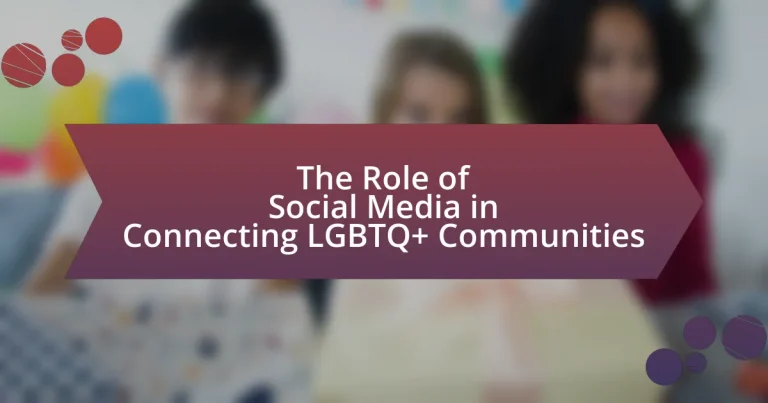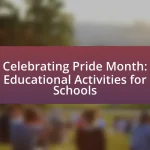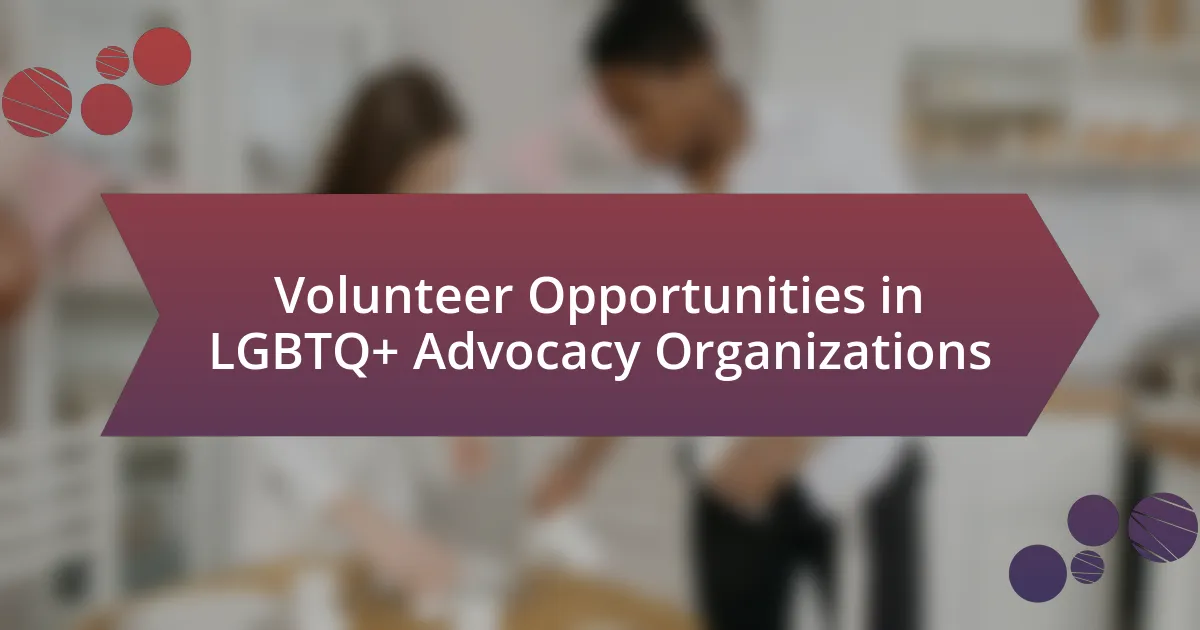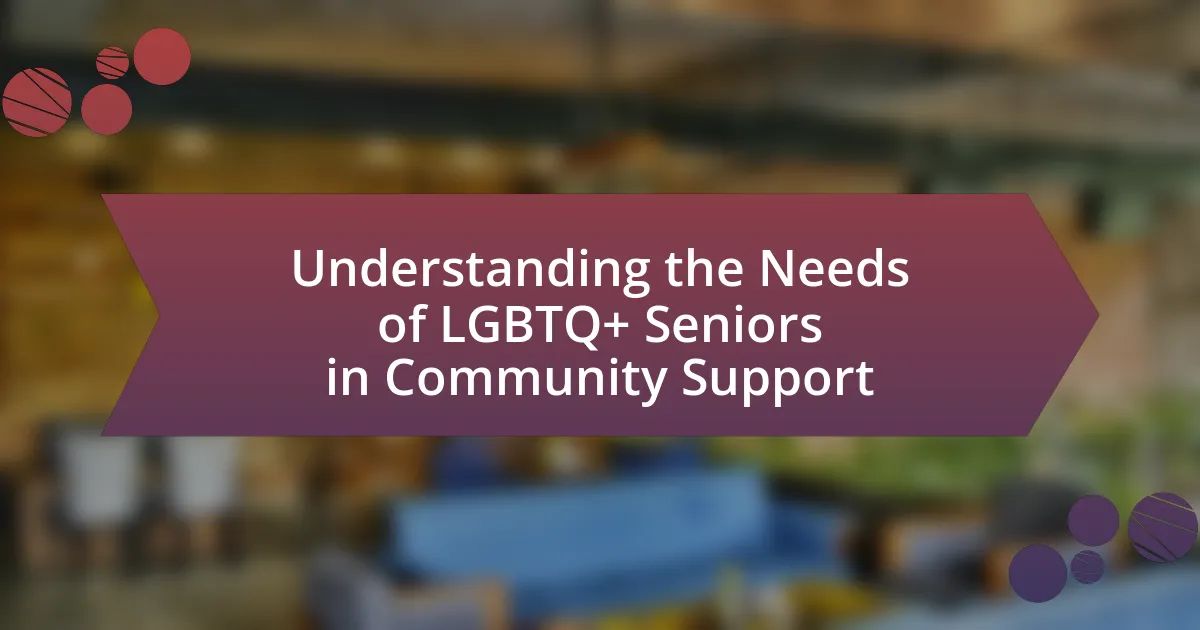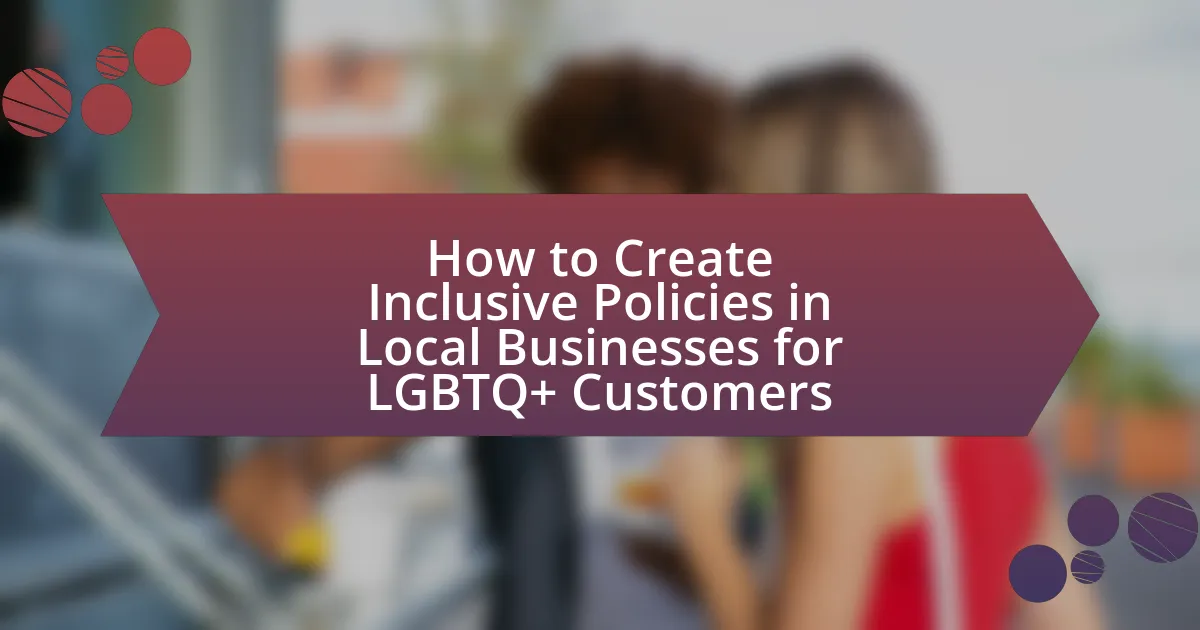The article examines the significant role of social media in connecting LGBTQ+ communities, highlighting its importance as a platform for communication, support, and advocacy. It discusses how social media facilitates connections among LGBTQ+ individuals, the most commonly used platforms, and the unique features that cater to their needs. The article also addresses the impact of social media on mental health, the challenges faced by LGBTQ+ individuals, and the ways in which social media promotes visibility and activism for LGBTQ+ rights. Additionally, it explores the potential risks associated with social media use and offers best practices for LGBTQ+ individuals to effectively engage online.

What is the Role of Social Media in Connecting LGBTQ+ Communities?
Social media plays a crucial role in connecting LGBTQ+ communities by providing platforms for communication, support, and advocacy. These platforms enable individuals to share experiences, find allies, and access resources that may not be available in their local environments. For instance, studies show that 70% of LGBTQ+ youth report feeling more accepted and supported through online interactions, highlighting the importance of social media in fostering a sense of belonging. Additionally, social media campaigns have successfully raised awareness and mobilized support for LGBTQ+ rights, demonstrating its effectiveness as a tool for social change.
How does social media facilitate connections within LGBTQ+ communities?
Social media facilitates connections within LGBTQ+ communities by providing platforms for individuals to share experiences, find support, and build networks. These platforms, such as Facebook, Instagram, and Twitter, allow users to connect with others who share similar identities and experiences, fostering a sense of belonging. Research indicates that 70% of LGBTQ+ individuals use social media to connect with their communities, highlighting its significance in combating isolation and promoting visibility. Additionally, social media serves as a tool for activism and awareness, enabling users to mobilize around issues affecting LGBTQ+ rights and representation, further strengthening community ties.
What platforms are most commonly used by LGBTQ+ individuals for connection?
LGBTQ+ individuals most commonly use platforms such as Grindr, Tinder, Facebook, Instagram, and Twitter for connection. Grindr and Tinder are particularly popular for dating and social networking within the community, with Grindr having over 13 million users globally, primarily focused on gay, bi, trans, and queer people. Facebook and Instagram serve as broader social networking platforms where LGBTQ+ individuals can connect, share experiences, and find community support, with Facebook reporting over 2.8 billion monthly active users. Twitter is also utilized for advocacy, sharing news, and connecting with LGBTQ+ voices, with millions of users engaging in conversations around LGBTQ+ issues.
How do these platforms cater specifically to LGBTQ+ needs?
Social media platforms cater specifically to LGBTQ+ needs by providing safe spaces for expression, community building, and access to resources. These platforms often implement features such as identity filters, inclusive language options, and community guidelines that promote respect and safety for LGBTQ+ users. For instance, Facebook and Instagram allow users to select from a variety of gender identities and sexual orientations, fostering a sense of belonging. Additionally, platforms like Grindr and HER are designed specifically for LGBTQ+ individuals, offering tailored features such as location-based networking and event promotion that directly address the unique social and dating needs of the community. Research indicates that 70% of LGBTQ+ individuals feel more connected to their community through social media, highlighting its role in facilitating support and advocacy.
Why is social media important for LGBTQ+ community building?
Social media is crucial for LGBTQ+ community building because it provides a platform for connection, support, and visibility. It enables individuals to share experiences, access resources, and foster relationships with others who share similar identities and challenges. According to a 2021 study by the Pew Research Center, 70% of LGBTQ+ adults reported that social media helps them feel more connected to their community, highlighting its role in reducing feelings of isolation. Additionally, social media serves as a space for activism and advocacy, allowing LGBTQ+ individuals to mobilize for rights and representation, which is essential for community empowerment and solidarity.
What unique challenges do LGBTQ+ individuals face that social media addresses?
LGBTQ+ individuals face unique challenges such as social isolation, discrimination, and lack of access to supportive communities, which social media effectively addresses. Social media platforms provide a space for LGBTQ+ individuals to connect with like-minded peers, share experiences, and find support, thereby reducing feelings of isolation. According to a study by the Pew Research Center, 70% of LGBTQ+ youth reported that social media helps them feel more connected to their communities. Additionally, social media serves as a vital tool for advocacy and awareness, allowing LGBTQ+ individuals to mobilize for rights and representation, which is crucial in combating discrimination and promoting acceptance.
How does social media promote visibility and representation for LGBTQ+ individuals?
Social media promotes visibility and representation for LGBTQ+ individuals by providing platforms for self-expression and community building. These platforms allow LGBTQ+ individuals to share their stories, experiences, and identities, which fosters a sense of belonging and visibility. According to a 2020 study by the Pew Research Center, 63% of LGBTQ+ adults reported that social media helps them connect with others who share similar experiences, enhancing their representation in public discourse. Furthermore, social media campaigns, such as Pride Month celebrations and hashtags like #LoveIsLove, amplify LGBTQ+ voices and issues, increasing awareness and acceptance in broader society.
What role does social media play in activism and advocacy for LGBTQ+ rights?
Social media serves as a crucial platform for activism and advocacy for LGBTQ+ rights by facilitating communication, mobilization, and awareness. It enables LGBTQ+ individuals and allies to share experiences, organize events, and disseminate information rapidly, thereby fostering community solidarity. For instance, campaigns like the #LoveWins hashtag during the 2015 U.S. Supreme Court ruling on same-sex marriage exemplify how social media can galvanize public support and influence policy changes. Additionally, studies indicate that social media usage among LGBTQ+ youth provides a sense of belonging and reduces feelings of isolation, further highlighting its role in promoting mental health and community engagement.
How do LGBTQ+ activists utilize social media to raise awareness?
LGBTQ+ activists utilize social media to raise awareness by creating campaigns that highlight issues such as discrimination, mental health, and legal rights. These campaigns often include hashtags, visual content, and personal stories that resonate with a wide audience, fostering community engagement and support. For instance, the #LoveIsLove campaign gained significant traction on platforms like Twitter and Instagram, promoting marriage equality and challenging homophobic narratives. Research indicates that social media can amplify marginalized voices, with a study by the Pew Research Center showing that 70% of LGBTQ+ individuals feel more connected to their community through social media platforms. This connection not only raises awareness but also mobilizes support for advocacy efforts and policy changes.
What impact has social media had on LGBTQ+ rights movements globally?
Social media has significantly advanced LGBTQ+ rights movements globally by providing a platform for visibility, advocacy, and community building. It has enabled activists to share information rapidly, mobilize support, and raise awareness about issues affecting LGBTQ+ individuals. For instance, the #LoveWins campaign on platforms like Twitter and Facebook played a crucial role in the U.S. Supreme Court’s decision to legalize same-sex marriage in 2015, demonstrating how online movements can influence legal outcomes. Additionally, social media has facilitated international solidarity, allowing LGBTQ+ communities in different countries to connect and support each other, as seen during global events like Pride Month. The ability to share personal stories and experiences has also fostered empathy and understanding, contributing to broader societal acceptance of LGBTQ+ rights.
How does social media influence mental health within LGBTQ+ communities?
Social media significantly influences mental health within LGBTQ+ communities by providing a platform for connection, support, and expression. Research indicates that LGBTQ+ individuals often face isolation and discrimination, and social media serves as a vital tool for fostering community and reducing feelings of loneliness. A study published in the Journal of Homosexuality found that LGBTQ+ youth who engage with online communities report higher levels of social support and lower levels of depression compared to those who do not use social media. Additionally, social media allows for the sharing of personal experiences and resources, which can empower individuals and promote mental well-being.
What support systems are available through social media for LGBTQ+ individuals?
Social media provides various support systems for LGBTQ+ individuals, including online communities, mental health resources, and advocacy networks. Platforms like Facebook, Twitter, and Instagram host groups and pages dedicated to LGBTQ+ issues, allowing users to connect with peers, share experiences, and seek advice. Research indicates that 70% of LGBTQ+ youth report feeling more accepted when they engage with online communities that reflect their identities. Additionally, organizations such as The Trevor Project and GLAAD utilize social media to offer crisis intervention, educational resources, and promote awareness, further enhancing the support available to LGBTQ+ individuals.
How can social media contribute to both positive and negative mental health outcomes?
Social media can contribute to both positive and negative mental health outcomes by providing support and connection while also facilitating comparison and cyberbullying. On the positive side, platforms like Facebook and Instagram allow LGBTQ+ individuals to find community, share experiences, and access resources that promote mental well-being, as evidenced by a study published in the Journal of Homosexuality, which found that online support networks significantly reduce feelings of isolation. Conversely, social media can lead to negative outcomes such as anxiety and depression due to exposure to harmful content, unrealistic comparisons, and instances of cyberbullying, with research indicating that LGBTQ+ youth are particularly vulnerable to these risks, as highlighted in a report by the Trevor Project, which states that 39% of LGBTQ+ youth reported being bullied online.
What are the potential risks associated with social media use in LGBTQ+ communities?
The potential risks associated with social media use in LGBTQ+ communities include exposure to harassment, privacy violations, and mental health challenges. Harassment can manifest as cyberbullying or targeted hate speech, which studies show can lead to increased anxiety and depression among LGBTQ+ individuals. Privacy violations occur when personal information is shared without consent, potentially leading to doxxing or discrimination. Additionally, the pressure to conform to social media norms can exacerbate feelings of inadequacy and isolation, as evidenced by research indicating that LGBTQ+ youth are more likely to experience negative mental health outcomes linked to social media use.
How can online harassment affect LGBTQ+ individuals on social media?
Online harassment can significantly impact LGBTQ+ individuals on social media by leading to mental health issues, social isolation, and decreased participation in online communities. Studies indicate that LGBTQ+ individuals experience higher rates of anxiety, depression, and suicidal thoughts due to targeted harassment, with a 2019 report from the Pew Research Center showing that 39% of LGBTQ+ adults have faced online harassment. This harassment can deter individuals from engaging with supportive communities, ultimately undermining the role of social media as a platform for connection and support within LGBTQ+ networks.
What measures can be taken to ensure safer online spaces for LGBTQ+ users?
To ensure safer online spaces for LGBTQ+ users, platforms should implement robust moderation policies that specifically address hate speech and harassment. Research indicates that 70% of LGBTQ+ individuals have experienced online harassment, highlighting the urgent need for effective measures. These measures include employing trained moderators who understand LGBTQ+ issues, utilizing AI tools to detect harmful content, and providing users with clear reporting mechanisms. Additionally, platforms can enhance user safety by allowing customizable privacy settings and creating supportive community guidelines that foster inclusivity.
How can LGBTQ+ individuals effectively use social media for connection and support?
LGBTQ+ individuals can effectively use social media for connection and support by engaging with online communities, sharing personal experiences, and accessing resources tailored to their needs. Social media platforms like Facebook, Twitter, and Instagram host numerous LGBTQ+ groups and pages that foster a sense of belonging and provide emotional support. Research indicates that 70% of LGBTQ+ youth report feeling more connected to their community through social media, highlighting its role in reducing feelings of isolation. Additionally, platforms often feature hashtags and campaigns that promote awareness and solidarity, allowing individuals to connect with others who share similar experiences and challenges.
What best practices should LGBTQ+ individuals follow when engaging on social media?
LGBTQ+ individuals should prioritize safety, authenticity, and community engagement when engaging on social media. Ensuring privacy settings are adjusted to limit exposure to unwanted attention is crucial; studies show that 70% of LGBTQ+ individuals have experienced online harassment, making it essential to protect personal information. Authenticity fosters genuine connections, as sharing personal experiences can resonate with others, creating a supportive environment. Engaging with LGBTQ+ organizations and communities online can provide resources and solidarity, as research indicates that social media can significantly enhance feelings of belonging among LGBTQ+ individuals.
How can LGBTQ+ communities leverage social media for networking and support?
LGBTQ+ communities can leverage social media for networking and support by creating dedicated online spaces that foster connection and dialogue. These platforms allow individuals to share experiences, seek advice, and build relationships with others who share similar identities and challenges. For instance, studies show that 70% of LGBTQ+ individuals use social media to connect with others in their community, highlighting its effectiveness as a tool for support and networking. Additionally, social media enables the organization of events, advocacy campaigns, and resource sharing, which further strengthens community ties and provides essential support systems.
